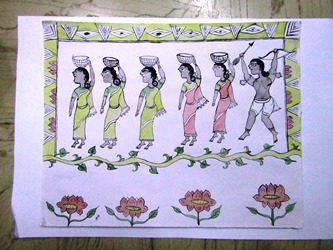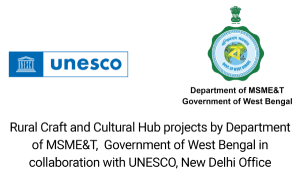 The Patachitra form practised in Purulia is strikingly different from the one in Medinipur. Purulia’s Patachitra stands out for its simple style and compositions, minimal background decoration, and use of natural colours made from stones and leaves. The Patachitra of Purulia is essentially a ritualistic practice associated with the events in the daily lives of people. Unlike its counterpart in Medinipur, Purulia Patachitra is relatively lesser known to the outside world. And so is the artists’ use of organic dyes. Created with simple, bold strokes, there is minimal use of colour and decoration, and rarely does one see more than two-three colors in the frames, but they stand out for their sheer aesthetic brilliance. As the base material they use paper easily available in the market. Especially, fullscape. The method to make the base strong and long lasting is not known. They have little idea of preservation. At the beginning of making pat, about 8’’ – 1’ part of the same is covered with plastic, which is easily available. It is done primary to protect the rest of the paper from water. Two handles on two sides are made with bamboo strips, help the artists to wind up the pat. It also becomes easier for the artists to unfurl the pat with the two handles.
The Patachitra form practised in Purulia is strikingly different from the one in Medinipur. Purulia’s Patachitra stands out for its simple style and compositions, minimal background decoration, and use of natural colours made from stones and leaves. The Patachitra of Purulia is essentially a ritualistic practice associated with the events in the daily lives of people. Unlike its counterpart in Medinipur, Purulia Patachitra is relatively lesser known to the outside world. And so is the artists’ use of organic dyes. Created with simple, bold strokes, there is minimal use of colour and decoration, and rarely does one see more than two-three colors in the frames, but they stand out for their sheer aesthetic brilliance. As the base material they use paper easily available in the market. Especially, fullscape. The method to make the base strong and long lasting is not known. They have little idea of preservation. At the beginning of making pat, about 8’’ – 1’ part of the same is covered with plastic, which is easily available. It is done primary to protect the rest of the paper from water. Two handles on two sides are made with bamboo strips, help the artists to wind up the pat. It also becomes easier for the artists to unfurl the pat with the two handles.
The Pater Gaan or the songs accompanying the scroll paintings showcase the culture of tribes like Santhals alongside the mainstream fare. There are many songs in Alchiki, reflecting an interchange of languages, and Santhal Pats coexist in harmony with the likes of Madanmohan Leela, Krishna Leela and Raas Leela. The spectrum of natural colours and their sources is amazing. Saffron is created from Geru Pathar stone, yellow ochre from Holud Pathar stone, white from Khorimati clay, black from a type of soot called Bhushokali. Orange comes from Kamala Pathar stone, green from Simpata leaves, purple from Pui Metuli leaves, pink from banyan buds or Boter Kuri, red from Phanimansha flowers, blue from Nil, and yellow from Palash flowers!
A total of 71 artists from Majramura village located in Purulia district are covered under the RCCH project.



